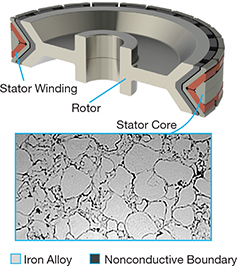Electric motor drives account for 60–70% of global industrial electricity consumption. Pump systems alone represent about 25% of all the electricity consumed by industrial electric motors, and account for roughly 18% of electricity used within the chemical industry. Motor efficiency gains, therefore, would significantly reduce operating costs in the chemical industry.
The current design of motors, however, limits efficiency improvements. The winding cores housed within the majority of today’s motors are made of laminated silicon steel. The laminates enable only a two-dimensional magnetic flux, typically in a radial-field arrangement, which limits the motor output, size, weight, and efficiency.
With funding from the National Science Foundation, Persimmon Technologies Corp., a Wakefield, MA, company, has engineered an advanced soft magnetic composite to replace the laminated winding cores. The new cores are solid isotropic components that can channel the magnetic flux in three dimensions while suppressing the formation of eddy currents, thereby minimizing the energy losses associated with them. The hybrid-field motors with the isotropic composite cores have a 40% higher power density and up to 15% lower energy losses than today’s state-of-the-art motors.
Persimmon Technologies produces the solid cores with a unique additive-manufacturing process, in which metals are sprayed as droplets in a reactive atmosphere to form a shaped component. A stream of powder particles made of a proprietary iron alloy is heated to a semi-molten state and accelerated to supersonic speed in the spray gun and then ejected into a reactive atmosphere. A chemical reaction, typically oxidation, takes place on the surface of the particles before they are deposited onto the substrate and solidify into a dense material. The solidified material has a composite microstructure made up of small grains (10–200 µm in diameter) separated from one another by thin insulating layers that are formed by the chemical reaction occurring on the particles’ surfaces.
The key to the higher output and efficiency enabled by the new cores is the isotropic nature of the material. Unlike silicon steel laminates, the composite cores allow the magnetic flux to travel in all directions. At the same time, the insulation boundaries between neighboring grains prevent the development of eddy currents.
Persimmon’s spray process can produce components ranging in size from millimeters to meters with deposition rates as high as 25 kg/sec, which is more than 100 times faster than the speed of typical 3D printing techniques. The company’s objective is to develop a single-step process that produces near-net shape components, which reduces the complexity and cost of the manufacturing process. According to Michael Pippins, Persimmon CEO, the technology has the potential to drive one of the most disruptive changes in the recent history of electric motors by delivering smaller, lighter, higher-output, and lower-cost products.
While different chemistries can be used in the spray-forming process, Persimmon has achieved particularly favorable results using a powder made of an iron-aluminum alloy combined with an oxygen-enriched atmosphere, which produces an aluminum-oxide layer on the surfaces of the powder particles as they travel through the reactive atmosphere. Aluminum oxide has the desirably low electrical conductivity that is necessary to suppress eddy currents, and remains stable at elevated temperatures, a property sought after for winding-core applications.

▲ Persimmon Technologies Corp. has developed a brushless permanent magnet hybrid-field motor (top) with a spray-formed core (bottom).
“Our spray-formed material features a very unique combination of electromagnetic, mechanical, and thermal properties,” says Martin Hosek, Persimmon CTO. The material is 14 times stronger, orders of magnitude harder, 10% lighter, and less porous (one-fifth the porosity) than alternative materials produced by compounding a mix of coated iron powder with an organic binder.
Persimmon has designed and produced multiple motor configurations with spray-formed winding cores, demonstrating the size, power, and efficiency benefits. “Persimmon’s technology is an impressive example of how advances in materials engineering can expand the boundaries of a mature industry,” says Om Nalamasu, president of Applied Ventures and CTO of Applied Materials.
This article was prepared by the National Science Foundation in partnership with CEP.

Copyright Permissions
Would you like to reuse content from CEP Magazine? It’s easy to request permission to reuse content. Simply click here to connect instantly to licensing services, where you can choose from a list of options regarding how you would like to reuse the desired content and complete the transaction.
